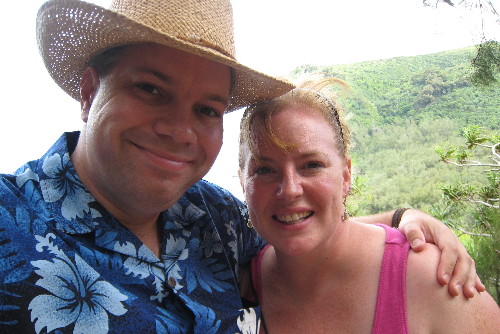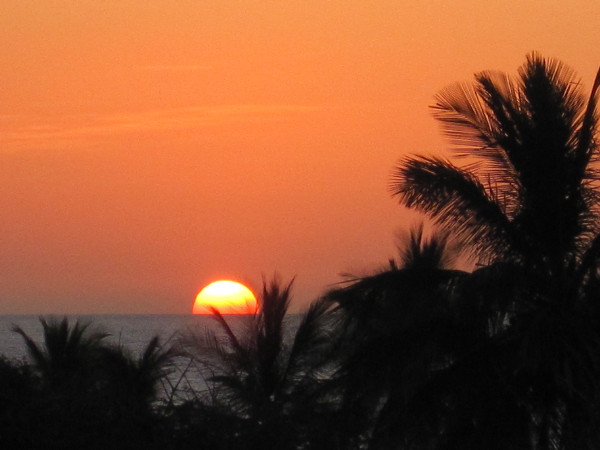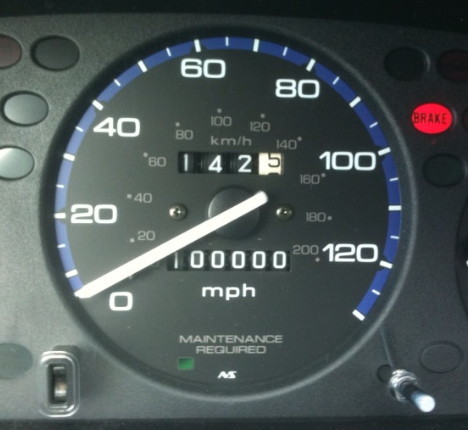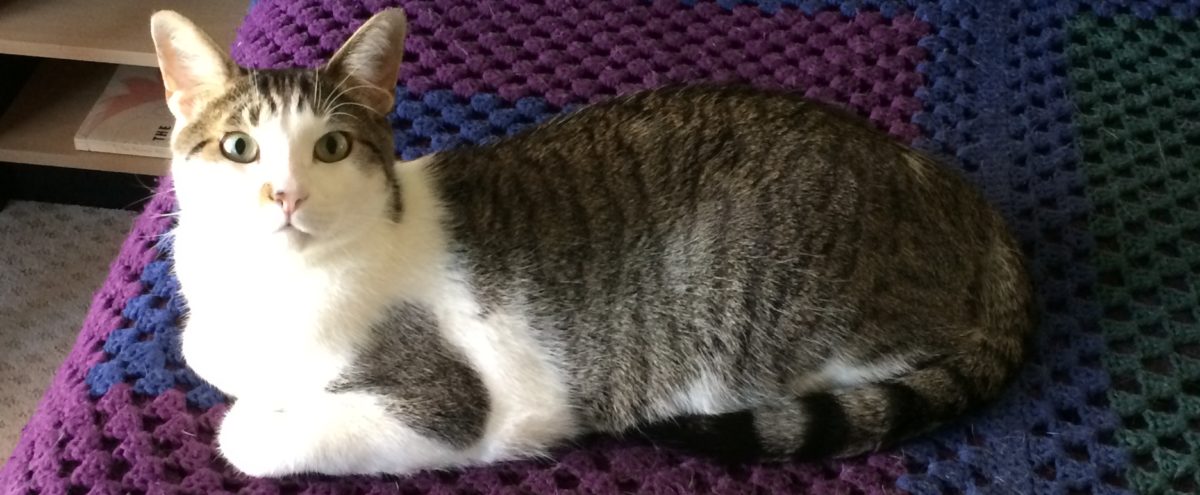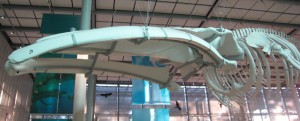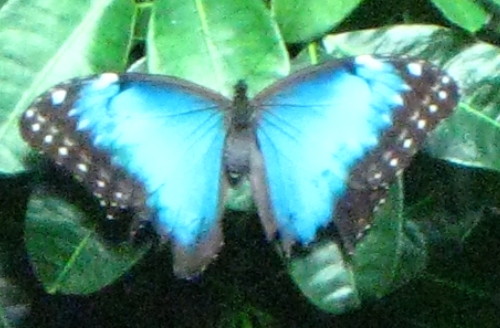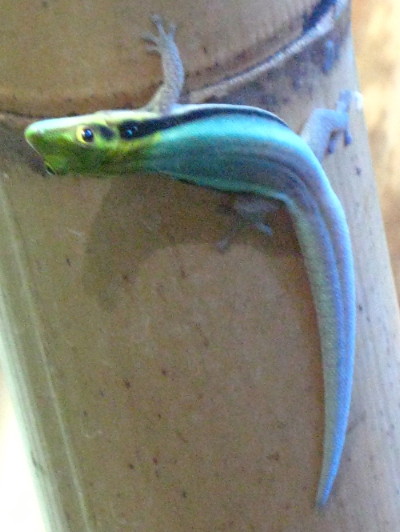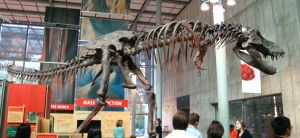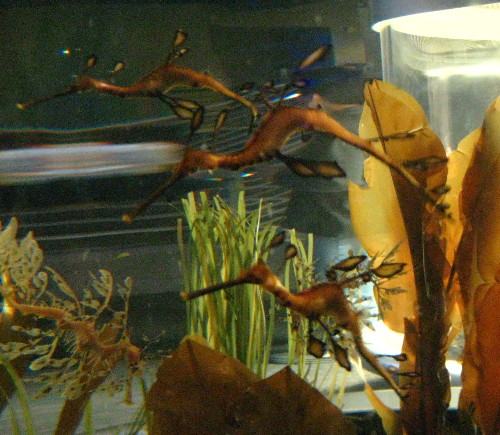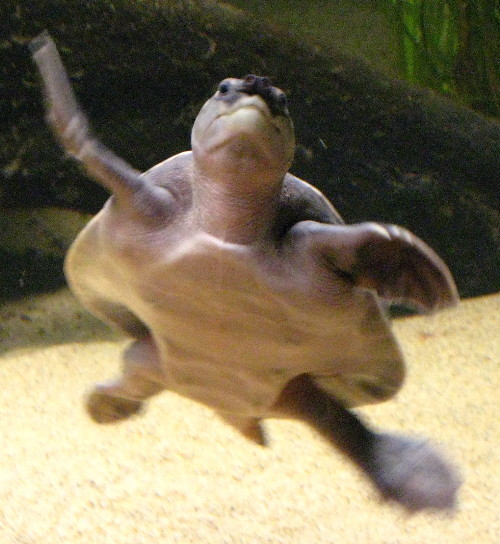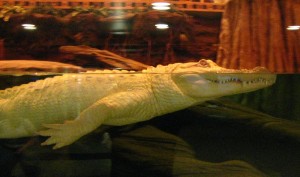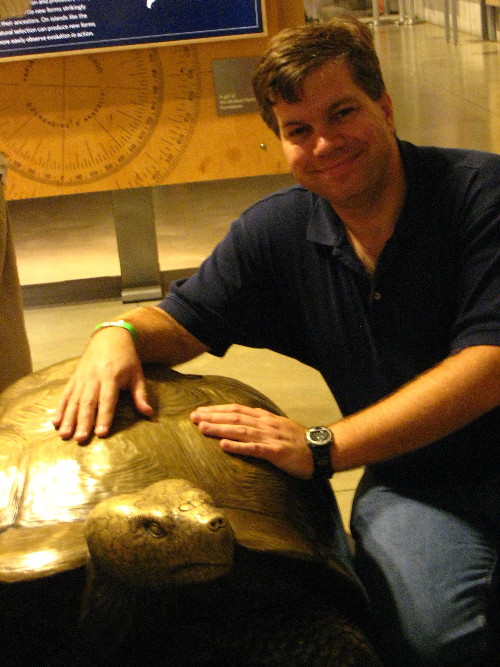It’s been a few days since we got back from our second trip to Hawaii. (Our first trip was back in 2003.) We flew out on Tuesday September 22, and went back to the big island of Hawaii, since after our first week there we figured there was at least another week’s worth of stuff to see. We used The Big Island Revealed as our guidebook again, picking up the latest edition, and again it was quite good.
Tuesday we woke up at 5 am PDT, caught a 9 am flight from San Francisco, and got in to the Kona airport at 11 am HST (there’s a 3-hour time shift at this time of year compared to the west coast). We unfortunately made the mistake of not eating enough early in the day, and even though we had a good-sized lunch, I ended up worn down and with a splitting headache by the evening. A good-sized dinner helped, but it made the later afternoon a bit of a downer, especially as we were shopping in downtown Kona in the heat and humidity. So basically: Not enough food, and doing too much on the day of our arrival. (I was also bummed to find that the Big Island Steak House in the nearby Kings Shops had closed since our last visit. Their food was good and plentiful, and their drinks were terrific, but I guess business just wasn’t good enough to stay afloat.) We ended up eating at Roy’s instead, which I think is okay, but rather pricy even by Hawaii standards.
Incidentally, we stayed again at the Waikoloa Beach Marriott, about 25 miles north of Kona, in the middle of the resort coast. While there isn’t much on the resort coast other than, well, resorts, it is a convenient place from which to get to several other parts of the island. We liked the hotel when we stayed there before, and they’ve renovated since then, so we were happy with it the second time, too.
Wednesday we started the day – as we almost always did on this trip – with breakfast and coffee from the coffee bar, followed by several hours in and by the hotel pools. Then we headed out in the car (okay, the boat, as we’d rented a Ford Expedition, which felt huge to drive, although it wasn’t bad once we got used to it) and headed into the north district of Kohala. There’s something about the land on the north coast that appeals to me: The grassy lands which gradually change to rainforest, the houses and towns and communities. Not a bad place to live, I imagine, so long as you don’t mind an hour’s drive to the nearest “major” city.
We stopped for lunch in the larger town of Waimea before heading north where we did the hike down the hill to the black sand beach in Pololu Valley. It was hot, muggy, and a steep hike over uneven terrain – and still worth it when we got to the bottom. We did this hike last time too, and perhaps next time we’ll go to one of the more accessible black sand beaches instead. On the way back we stopped at Tropical Dreams in Hawi for some ice cream. Alas, I was sad to see that the Kohala Book Shop closed earlier this year, as they were a nifty used book store in Kapa’au where I found some neat stuff on our last trip. But I imagine trying to run a used bookstore in a remote part of a tropical island is a difficult feat to pull off for a long time.

(click on icons to view
a larger image)
Most of our days ended with us heading back to the hotel to shower since we would get pretty grubby on our travels, and put on clean clothes for dinner. On this day we drove up to the Cafe Pesto, which I think is the closest good restaurant to our hotel which isn’t on a resort, about 10 miles away. We think they’ve moved since last time we went there, to a larger venue with a larger menu. They’re still good, though. We got mixed drinks at almost every dinner on our vacation, which ain’t bad.
Thursday was one of our two forays over to the larger town of Hilo, which is unlike anything on the island, as it appears to have been mostly built in the 40s and 50s, and not significantly updated since then, so it almost looks like something out of an old movie. On the way we stopped at Huli Sue’s in Waimea for lunch, which I think may be my favorite restaurant we ate at on this trip. Very good BBQ, very good milkshakes.
The weather on this trip was funky: A little overcast at the hotel when we left, but cloudy and lightly raining in Waimea, which is up at 2500 feet. As we drove east towards Hilo, we drove through a heavy rain squall, and then into sunshine along the north coast. By the time we got to Hilo it was overcast again. Then we drove down into the eastern district of Puna, which we hadn’t really gone to last time, and which was mostly overcast and raining. It also, oddly, had one of the widest stretches of highway on the whole island. Maybe Puna is more built up than it appears and the lanes are needed for the travel to and from Hilo.
Originally, I’d planned for us to see some of the sights along the Puna coast, but before we’d set out I’d checked our guidebook’s web page to see where the current lava flow is, and it turns out we could get to it from the Puna side of the island. So we drove down towards the flow, and soon saw a giant steam plume where the lava was flowing into the ocean, at the end of a grinded lava road the state maintained. We headed down to the road where we were confronted with signs saying it was only open from 5-8 pm, and it was currently about 3 pm. Unsure what to do we waited a little while, and then several cars blew past us, and one guy in a coffee truck waved us to follow him.
It turns out that the road is open all the time (it’s a funky mix of ground-down lava and old road from the town of Kalapana, which was mostly destroyed by the lava flow about 20 years ago), but the actual walk to the viewing site is on private land, and due to budget issues the state only has guides for a limited time each day, around sunset when the viewing is best, so the viewing area didn’t open until 5. However, a number of vendors set up at the end of the road to sell art, coffee, flashlights, etc., and arrive early to get the good spots. So we drove up along the Puna coast, through the rainforest, and stopped to see the ocean several times, taking some good pictures of the blue water, and occasionally getting rained on. That killed time until we returned around 5, and hiked out to the viewing area.
It was not a terrific view, as we were about half a mile from the lava flow, so our view was quite distant. (I guess much of the land between the viewing area and the flow is various private lands so we couldn’t get any closer for legal reasons.) But as the sun set we were able to get some pretty good pictures and camera-films of the plume and the glow of the lava, occasionally seeing some lava flow over the edge on our side. We’d completely missed out on seeing lava last time we were here, so it was great to see some of it this time. Maybe next visit we’ll get even closer! On the drive back we stopped for dinner at Pescatore, which is a pretty good traditional Italian restaurant. I seem to recall the food being a little better last time we were here, but it was still good.

Friday we decided to take things a little easier after our adventures, although it didn’t quite turn out that way.
We had lunch in Kona, at Jackie Rey’s Ohana Grill, which was quite good and I think was Debbi’s favorite restaurant on the trip. Then we drove down to Kona coffee country, and bought coffee at both Greenwell Farms and Bay View Farm. Kona coffee is plenty expensive ($25-$30 per pound), but it’s soooooo good, so we bought several pounds. Everyone at both farms were very friendly, but we also learned from these visits (among others) that the recession has been hitting Hawaii hard, as tourism is really down. We’d noticed this at our hotel, too, as the pool was much quieter than last time. I imagine the coffee farms rely on tourists quite a bit, so I hope they can make it.
I made a friend at Bay View, a brightly-colored gecko who was licking the dry coffee creamer, and of which I got some good pictures and a video.

I thought it would be neat to do an easier hike, going down to the natural “arch city” along the cost in Honaunau, north of the Place of Refuge (which we visited last time). Unfortunately, it wasn’t so easy. First we had trouble spotting the entrance to the gravel path through the forest leading to the coast, although we found it after a little trial and error. The path is a little tricky to follow, but not too bad. But when we got to the coast, it was quite rocky, and we had to be careful to avoid spots where the ocean waves might splash up on to us (and, more importantly, try to drag us into the ocean). We hiked maybe half a mile along the coast, and saw a couple of arches, but we couldn’t get close enough to get a real good view of any of them, although seeing the water ebb and flow in them, and sometimes blow out a hole at the other end, was pretty neat. But overall it was less impressive than I’d hoped.
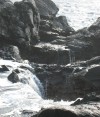
The real excitement came when we turned around to head back (rather than continuing the 3-mile circle the guidebook recommends); we couldn’t find the path back! At one point we thought we spotted the path, so we forged into the forest, but it didn’t look familiar.
And then I walked into a spider web. And got a big-ass brown spider crawling over me (maybe an inch and a half from leg to leg).
And Debbi hates spiders.
So I was frantically trying to brush the thing off of me – off of my brown Hawaiian shirt – and it took several tries before I did so. And then we tried to find our way back to the coast, but as I looked around, it seemed like every path had an even bigger spider in a giant web blocking the way (some of them were bright blue or green, but some of them were also twice as big as the one I’d already met). Yes, we were trapped in The Grove of Big-Ass Spiders.
Finally I calmed down enough to look around and figure out how we’d gotten in, so we got back to the coast. Debbi finally noticed that we hadn’t gone back far enough, so we walked back the rest of the way, found the path back to the road, and made it out.
But that was a lot more excitement for a lot less pay-off than we’d hoped. My guess is that the arches look a lot more impressive from a boat in the ocean. Oh well.
After this we were pretty much done for the day, so we drove back to the hotel, had dinner at a nearby restaurant, and collapsed for the evening. Whew!
Despite this, on Saturday we headed out early – the one day we didn’t spend by the pool – for the big adventure I’d most wanted to go on: Driving to South Point, which itself is neat enough, and then hiking an hour each way to the green sand beach. We’d skipped this hike last time since Debbi was recovering from a sprained ankle and we didn’t want to risk something happening on that hike. On the drive down we stopped for breakfast at the Aloha Theatre Cafe, whose french toast breakfast with coconut syrup was totally yummy, and which we highly recommend.
The hike, it turns out, is not so bad; the ground is not very even, but we made pretty good time, and it was always pretty easy to figure out which way to go. We were also fortunate that the wind was not so bad, and that it was overcast and cooler than it might have been. Once we got to the beach, which is at the bottom of a steep incline, we tried to figure out how to get down to it. Some folks we passed told us to go to a sign on the near side, climb down some rocks, and then take a path around the edge of the incline to the beach. We found the sign, but going down – and, more importantly, back up – the rocks looked pretty daunting, so we passed. Instead we walked around to the top of the cliff to get a better look. Well, when we did so, we saw people scaling the cliff pretty easily to get up and down. It turns out there’s a short ladder at the top to get you down the toughest part, and then you can work your way down the sandstone along some inclines, and use some stairs people have carved into the sandstone to get down. It’s not trivial, but it was actually pretty easy once we saw what to do. So we went down to the beach and hung out for a while, marveling at the green sand, and watching swimmers and even one diver enjoying the water.

On the walk back we passed several people going to the beach. At one point two women in a jeep asked us if it was worth it, and we said yes! We made it back to the car, a little tired but very happy to have made the trip, and drove back to the hotel (well, we stopped to buy some donkey balls at Surfin Ass on the way). We were pretty exhausted, so we had dinner at the hotel restaurant, which was okay, although rather overpriced. (Saturday they give 30% off your bill, which helped.) On the bright side, it was more food than we could actually eat! Afterwards we changed and went down to the hot tub, where we chatted with one couple for a while before they went in, and then were joined by a couple of women – who turned out to be the same women who’d passed us on the way back from the green sand beach and asked us whether it was worth it! They agreed that it was. Apparently they’d spend 5 days on Maui and then 5 days on the big island, and had driven all over the place on both islands, and this night was the one time they’d really used the hotel pools at all – and they were leaving the next day. One of them wondered if they could stay another day, and the other one said the “marginal value” of staying wouldn’t equal the cost, which amused me since I hear the term “marginal value” mainly in baseball analysis; she said she’s an accountant, which makes sense. I guess everyone uses the geek-speak from their profession in humorous contexts from time to time.
Sunday we used as an off-day, driving into Kona and eating and shopping for most of the afternoon. The weather was overcast and cool, so it wasn’t too uncomfortable to be walking from store to store. Our one disappointment was that we’d wanted to go back to Jackie Rey’s for lunch, but they’re closed for lunch on Sundays. Alas.
Monday we drove back to Hilo, or nearly so, having lunch at Huli Sue’s, and visiting the Hawaii Tropical Botanical Garden, which was the last major sight on the island I really wanted to see. It’s beautiful! A lot of vertical walking to get from the road to the garden, though, but they have lots of tropical plants and flowers, a waterfall, and a beautiful coastal view. Well worth the entry fee, I thought. We also drove to Akaka Falls, which was okay, but not really a must-see.
In the evening Debbi wanted to do some shopping nearby. She ended up buying a pendant at the Pearl Factory, and getting a much-larger-than-average pearl in the bargain. Good deal! We had dinner, lay in one of the lounge chairs on the patio for a while, and finished the evening with a dip in the hot tub.
Tuesday it was time to head home. Sob! We got to the airport way early, so we had plenty of time to cool our heels and be sad to be leaving. On the other hand, we blew through security in no time at all, which beats standing in long lines. Unlike our trip back from Boston in June, this flight went completely smoothly, landing in San Francisco a little early, and we were home by 10 pm. We both took Wednesday off to catch up on important stuff after the vacation, and it was nice to see the cats again (Newton was so excited he kept waking us up overnight, which was not appreciated).
But now we’re already looking forward to going back again. Not sure when that’s going to happen, but hopefully before another 6 years have passed!
